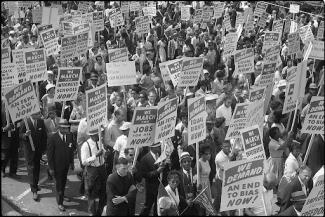
In 1911, A. Philip Randolph wanted to create change.
He studied the politics of labor unions and economic theories until he settled on a plan for Black liberation which focused on pay.
Randolph became a master organizer and led the Brotherhood of Sleeping Car Porters’ fight for equal treatment, better wages, and benefits.
To Randolph, liberation meant upgrading our collective economic influence by challenging workforce inequality. Soon, he expanded his vision to federal fights.
Randolph led the original March On Washington For Jobs And Freedom in 1941, which threatened political pressure that Presidents Franklin and Truman BOTH signed executive orders barring discrimination related to defense contracts and desegregating the U.S. army.
He used the tactic again with the March On Washington of 1963 that pressured President John F. Kennedy to initiate a strong federal civil rights bill and set the stage for Martin Luther King’s famous “I Have A Dream” speech.
Attorney General A. Mitchell Palmer called Randolph “the most dangerous Negro in America” because of Randolph’s drive to direct economic power into the hands of Black business owners and workers in the form of big contracts and jobs.
What if we could continue to manifest such Black power and unity today?